Study on Rheological and Mechanical Properties of Aeolian Sand-Fly Ash-Based Filling Slurry
Abstract
1. Introduction
2. Experimental Materials and Methods
2.1. Experimental Materials
2.2. Experimental Schemes
3. Results and Discussion
3.1. Rheological Test Results
3.1.1. Rheological Model, Yield Stress and Plastic Viscosity
3.1.2. Thixotropic Properties
3.1.3. Rheological Properties at Constant Shear Rate
3.2. Mechanical Test Results
4. Discussion
5. Conclusions
- (1)
- The rheological properties of aeolian sand-fly ash-based filling slurry conform to the Bingham model.
- (2)
- Thixotropy of aeolian sand-fly ash-based filling slurry increases with the increase of fly ash content. When the amount of fly ash is 22.5%–30%, the area of the thixotropic ring increases very significantly.
- (3)
- The fly ash content and the shear yield force meet a quadratic function relationship of y = 17.14 − 0.8x + 0.11x2. As the fly ash content increases, the backfill body’s resistance to deformation increases and its plasticity increases.
- (4)
- Increasing the amount of fly ash can improve the cohesiveness of the slurry, which is beneficial to the slurry and the slurry does not segregate. When the fly ash content is 30%, the plastic viscosity can reach the maximum value of 4.79 Pa·s in this experiment. However, with the increase of the amount of fly ash, the fluidity of the slurry also weakens, which is not conducive to pumping the slurry.
- (5)
- The strength of aeolian sand based fly ash filling increases with the increase of fly ash content; the influence of fly ash on the strength of the filling body is mainly reflected in the enhancement of the strength at the later stage, but the influence on the medium-term strength is not obvious.
Author Contributions
Funding
Conflicts of Interest
References
- Shao, X.P.; Li, X.; Wang, L.; Fang, Z.Y.; Zhao, B.; Liu, E.; Tao, Y.; Liu, L. Study on the pressure-bearing law of backfilling material based on three-stage strip backfilling mining. Energies 2020, 13, 211. [Google Scholar] [CrossRef]
- Zingano, A.; Weiss, A. Subsidence over room and pillar retreat mining in a low coal seam. Int. J. Min. Sci. Technol. 2019, 29, 51–57. [Google Scholar] [CrossRef]
- Yu, Y.; Deng, K.Z.; Fan, H.D. Long-term stability evaluation and coal pillar design methods for strip mining. J. China Coal Soc. 2017, 42, 3089–3095. [Google Scholar]
- Qian, M.G.; Xu, J.L.; Miao, X.X. Green technique in coal mining. J. China Univ. Min. Technol. 2003, 32, 343–348. [Google Scholar]
- Ma, L.Q.; Zhang, D.S.; Jin, Z.Y.; Wang, S.T.; Yu, Y.H. Theories and methods of efficiency water conservation mining in short-distance coal seams. J. China Coal Soc. 2019, 44, 727–738. [Google Scholar]
- Chen, S.J.; Du, Z.W.; Zhang, Z.; Zhang, H.W.; Xia, Z.G.; Feng, F. Effects of chloride on the early mechanical properties and microstructure of gangue-cemented paste backfill. Constr. Build. Mater. 2020, 235, 117504. [Google Scholar] [CrossRef]
- Liu, L.; Xin, J.; Huan, C.; Qi, C.C.; Zhou, W.W.; Song, K.I. Pore and strength characteristics of cemented paste backfill using sulphide tailings: Effect of sulphur content. Constr. Build. Mater. 2020, 237, 117452. [Google Scholar] [CrossRef]
- Yin, B.; Kang, T.H.; Kang, J.T.; Chen, Y. Experimental and Mechanistic Research on Enhancing the Strength and Deformation Characteristics of Fly-Ash-Cemented Filling Materials Modified by Electrochemical Treatment. Energy Fuels 2018, 32, 3614–3626. [Google Scholar] [CrossRef]
- Sun, Q.; Zhang, J.; Zhou, N. Study and discussion of short- strip coal pillar recovery with cemented paste backfill. Int. J. Rock Mech. Min. Sci. 2018, 104, 147–155. [Google Scholar] [CrossRef]
- Wang, P.; Hu, Y.N.; Cheng, H.F. Municipal solid waste (MSW) incineration fly ash as an important source of heavy metal pollution in China. Environ. Pollut. 2019, 252, 461–475. [Google Scholar] [CrossRef]
- Baram, M.S.; Sharma, J.; Singh, R.; Pugazhendhi, A. Industrial wastes: Fly ash, steel slag and phosphogypsum- potential candidates to mitigate greenhouse gas emissions from paddy fields. Chemosphere 2020, 241, 124824. [Google Scholar]
- Bhatt, A.; Priyadarshini, S.; Mohanakrishnan, A.A.; Abri, A.; Sattler, M.; Techapaphawit, S. Physical, chemical, and geotechnical properties of coal fly ash: A global review. Case Stud. Constr. Mater. 2019, 11, e00263. [Google Scholar] [CrossRef]
- Shekhovtsova, J.; Kovtun, M.; Kearsley, E.P. Evaluation of short- and long-term propertiesof heat-cured alkali-activated fly ash concrete. Mag. Concr. Res. 2015, 67, 897–905. [Google Scholar] [CrossRef]
- Liu, X.; Nair, S.; Aughenbaugh, K.; van Oort, E. Mud-to-cement conversion of non-aqueousdrilling fluids using alkali-activated fly ash. J. Pet. Sci. Eng. 2019, 182, 106242. [Google Scholar] [CrossRef]
- Fládr, J.; Bílý, P.; Chylík, R.; Prošek-Solid State Phenomena, Z. Macroscopic and Microscopic Properties of High Performance Concrete with Partial Replacement of Cement by Fly Ash. Solid State Phenom. 2019, 292, 108–113. [Google Scholar] [CrossRef]
- Teixeira, E.R.; Camões, A.; Branco, F.G.; Aguiar, J.B.; Fangueiro, R. Recycling of biomassand coal fly ash as cement replacement material and its effect on hydration and carbonation of concrete. Waste Manag. 2019, 94, 39–48. [Google Scholar] [CrossRef]
- Krishnaraj, L.; Ravichandran, P.T. Investigation on grinding impact of fly ash particles and its characterization analysis in cement mortar composites. Ain Shams Eng. J. 2019, 10, 267–274. [Google Scholar] [CrossRef]
- Dong, H.Z.; Feng, G.; Guo, Y. Pipe transportation characteristics of filling slurry in Xinyang mine. J. Min. Saf. Eng. 2013, 30, 880–885. [Google Scholar]
- Fu, Z.G.; Qiao, D.P.; Guo, Z.L.; Jincheng, X.; Fei, H.; Jiaxin, W. Experimental research on mixture proportion and strength of cemented hydraulic fill with waste rock and eolian sand based on RSM-BBD. J. China Coal Soc. 2018, 43, 694–703. [Google Scholar]
- Fang, K.; Fall, M. Chemically Induced Changes in the Shear Behaviour of Interface Between Rock and Tailings Backfill Undergoing Cementation. Rock Mech. Rock Eng. 2019, 52, 3047–3062. [Google Scholar] [CrossRef]
- Jiang, D.B.; Li, X.G.; Lv, Y.; Zhou, M.K.; He, C.H.; Jiang, W.; Liu, Z.; Li, C. Utilization of limestone powder and fly ash in blended cement: Rheology, strength and hydration characteristics. Constr. Build. Mater. 2020, 232, 117228. [Google Scholar] [CrossRef]
- Yin, B.; Kang, T.H.; Kang, J.T.; Chen, Y.; Wu, L.; Du, M. The research of the hydration kinetics process and hydration mechanismof fly ash paste filling materials. Chin. J. Rock Mech. Eng. 2018, 37, 4384–4394. [Google Scholar]
- Ren, A.; Feng, G.R.; Guo, Y.X.; Qi, T.Y.; Guo, J.; Zhang, M. Influence on performance of coal mine filling paste with fly ash. J. China Coal Soc. 2014, 39, 2374–2380. [Google Scholar]
- Deng, X.J.; Zhang, J.X.; Klein, B.; Zhou, N. Benjamin deWit, Experimental characterization of the influence of solid components on the rheological and mechanical properties of cemented paste backfill. Int. J. Miner. Process. 2017, 168, 116–125. [Google Scholar] [CrossRef]
- Jiao, D.W.; Shi, C.J.; Yuan, Q. Influences of shear-mixing rate and fly ash on rheological behavior of cement pastes under continuous mixing. Constr. Build. Mater. 2018, 188, 170–177. [Google Scholar] [CrossRef]
- Ren, Q.; Jiang, Z.W.; Li, H.X.; Zhu, X.P.; Chen, Q. Fresh and hardened properties of self-compacting concrete using silicon carbide waste as a viscosity-modifying agent. Constr. Build. Mater. 2019, 200, 324–332. [Google Scholar] [CrossRef]
- Dong, W.; Lyu, S.; Xue, G. Effect of Aeolian Sand and Fly Ash Content on Mechanical Properties of Concrete. Bull. Chin. Ceram. Soc. 2018, 37, 2320–2325. [Google Scholar]
- Cao, X.F.; Tang, Y.C.; Deng, N.D.; Shang, H.; Wang, Y. Aeolian Sand Paste Filling Material Ratio Based on Repeated Orthogonal Test. Saf. Coal Mines 2019. [Google Scholar] [CrossRef]
- Agrawal, U.S.; Wanjari, S.P.; Naresh, D.N. Impact of replacement of natural river sand with geopolymer fly ash sand on hardened properties of concrete. Constr. Build. Mater. 2019, 209, 499–507. [Google Scholar] [CrossRef]
- Liu, L.; Fang, Z.Y.; Qi, C.C. Experimental investigation on the relationship between pore characteristics and unconfined compressive strength of cemented paste backfill. Constr. Build. Mater. 2018, 179, 254–264. [Google Scholar] [CrossRef]
- Wang, J.; Wu, H.J.; Feng, X.W.; Pi, A.G.; Li, J.Z.; Huang, F.L. Dynamic spherical cavity expansion analysis of concrete using the Bingham liquid constitutive model. Int. J. Impact Eng. 2018, 120, 110–117. [Google Scholar] [CrossRef]
- Liu, Y.; Shi, C.J.; Jiao, D.W.; An, X.P. Rheological Properties, Models and Measurements for Fresh Cementitious Materials—A Short Review. J. Chin. Ceram. Soc. 2017, 45, 708–716. [Google Scholar]
- Zhou, H.Q.; Hou, C.J.; Sun, X.K.; Qu, Q.D.; Chen, D.J. Solid waste paste filling for none-village-relocation coal mining. J. China Univ. Min. Technol. 2004, 33, 154–158. [Google Scholar]
- Sun, Q.; Tian, S.; Sun, Q.W.; Li, B.; Cai, C.; Xia, Y.; Wei, X.; Mu, Q. Preparation and microstructure of fly ash geopolymer paste backfill material. J. Clean. Prod. 2019, 225, 376–390. [Google Scholar] [CrossRef]
- Agnieszka, W.; Lidia, B.; Wojciech, F. Fly ash as low cost and environmentally friendly backfill body and its effect on the properties of mix asphalt. J. Clean. Prod. 2019, 235, 493–502. [Google Scholar]
- Javid, A.A.S.; Ghoddousi, P.; Amiri, G.G.; Donyadideh, K. A new photogrammetry method to study the relationship between thixotropy and bond strength of multi-layers casting of self-consolidating concrete. Constr. Build. Mater. 2019, 204, 530–540. [Google Scholar] [CrossRef]
- Jiao, D.W.; Shi, C.J.; Yuan, Q. Time-dependent rheological behavior of cementitious paste under continuous shear mixing. Constr. Build. Mater. 2019, 226, 591–600. [Google Scholar] [CrossRef]
- Park, C.K.; Noh, M.H.; Park, T.H. Rheological properties of cementitious materials containing mineral admixtures. Cem. Concr. Res. 2005, 35, 842–849. [Google Scholar] [CrossRef]
- Marsh, B.K.; Day, R.L. Pozzolanic and cementitious reactions of fly ash in blended cement pastes. Cem. Concr. Res. 1988, 18, 301–310. [Google Scholar] [CrossRef]
- Chindasiriphan, P.; Yokota, H.; Pimpakan, P. Effect of fly ash and superabsorbent polymer on concrete self-healing ability. Constr. Build. Mater. 2020, 233, 116975. [Google Scholar] [CrossRef]
- Deschner, F.; Winnefeld, F.; Lothenbach, B.; Seufert, S.; Schwesig, P.; Dittrich, S.; Goetz-Neunhoeffer, F.; Neubaue, J. Hydration of Portland cement with high replacement by siliceous fly ash. Cem. Concr. Res. 2012, 42, 1389–1400. [Google Scholar] [CrossRef]
- Liu, L.; Fang, Z.Y.; Qi, C.C.; Zhang, B.; Guo, L.; Song, K.I.I.L. Numerical study on the pipe flow characteristics of the cemented paste backfill slurry considering hydration effects. Powder Technol. 2019, 343, 454–464. [Google Scholar] [CrossRef]
- Horiuchi, S.; Odawara, T.; Takiwaki, H. Coal fly ash slurries for back-filling. Stud. Environ. Sci. 1991, 48, 545–552. [Google Scholar]
- Shaban, W.M.; Yang, J.; Su, H.; Liu, Q.-F.; Tsang, D.C.W.; Wang, L.; Xie, J.; Li, L. Properties of recycled concrete aggregates strengthened by different types of pozzolan slurry. Constr. Build. Mater. 2019, 216, 632–647. [Google Scholar] [CrossRef]
- Min, C.D.; Li, X.B.; He, S.Y.; Zhou, S.T.; Zhou, Y.N. Effect of mixing time on the properties of phosphogypsum-based cemented backfill. Constr. Build. Mater. 2019, 210, 564–573. [Google Scholar] [CrossRef]
- Yin, B. Research on the Fly Ash Cemented Filling Materials and Its Modification and Further Application. Ph.D. Thesis, Taiyuan University of Technology, Taiyuan, China, 2018. [Google Scholar]
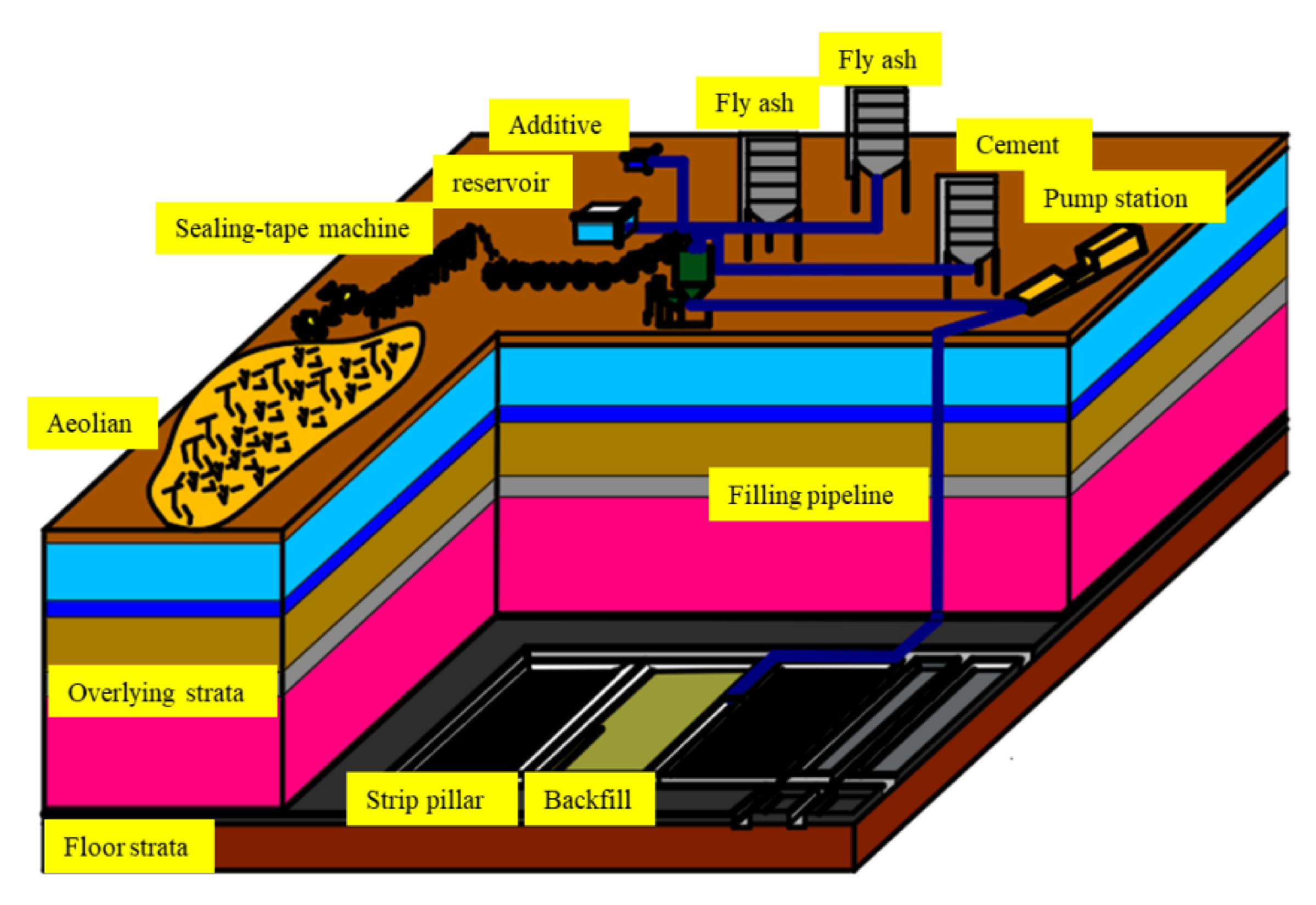

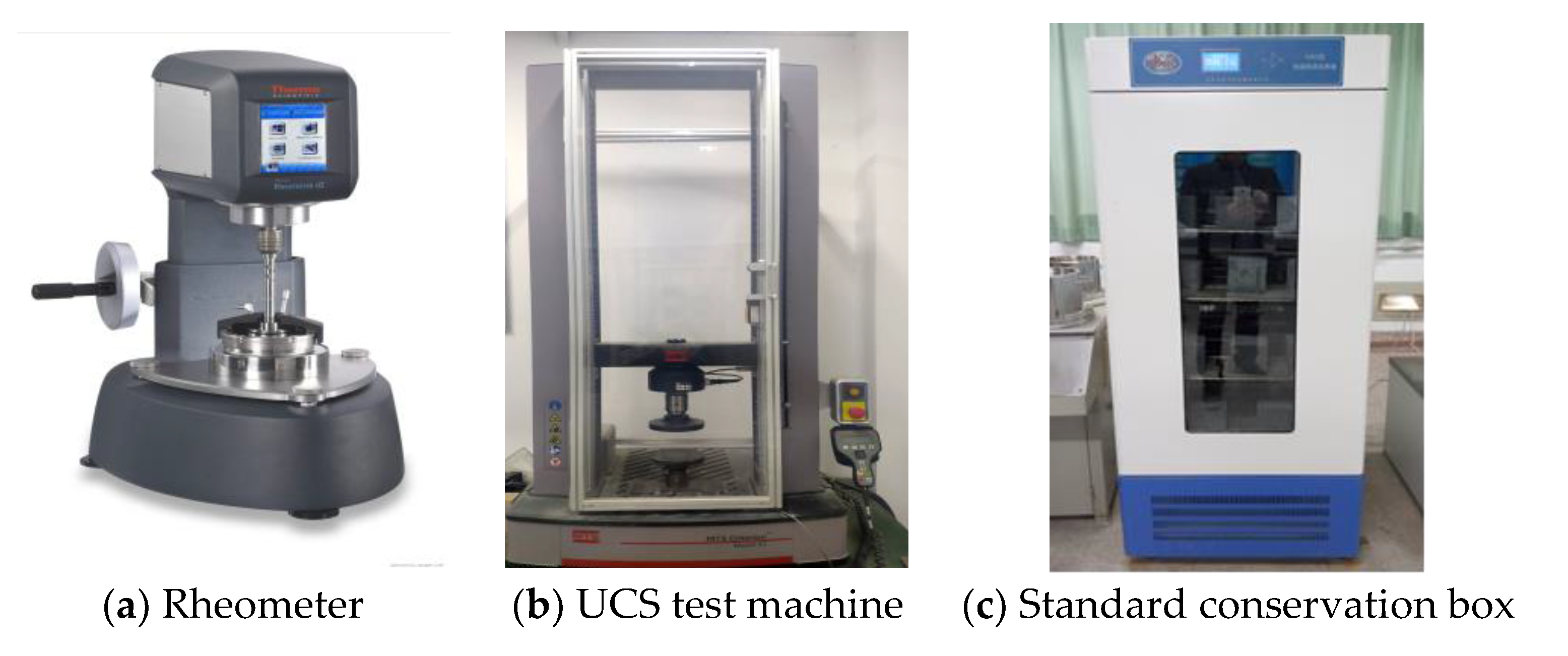
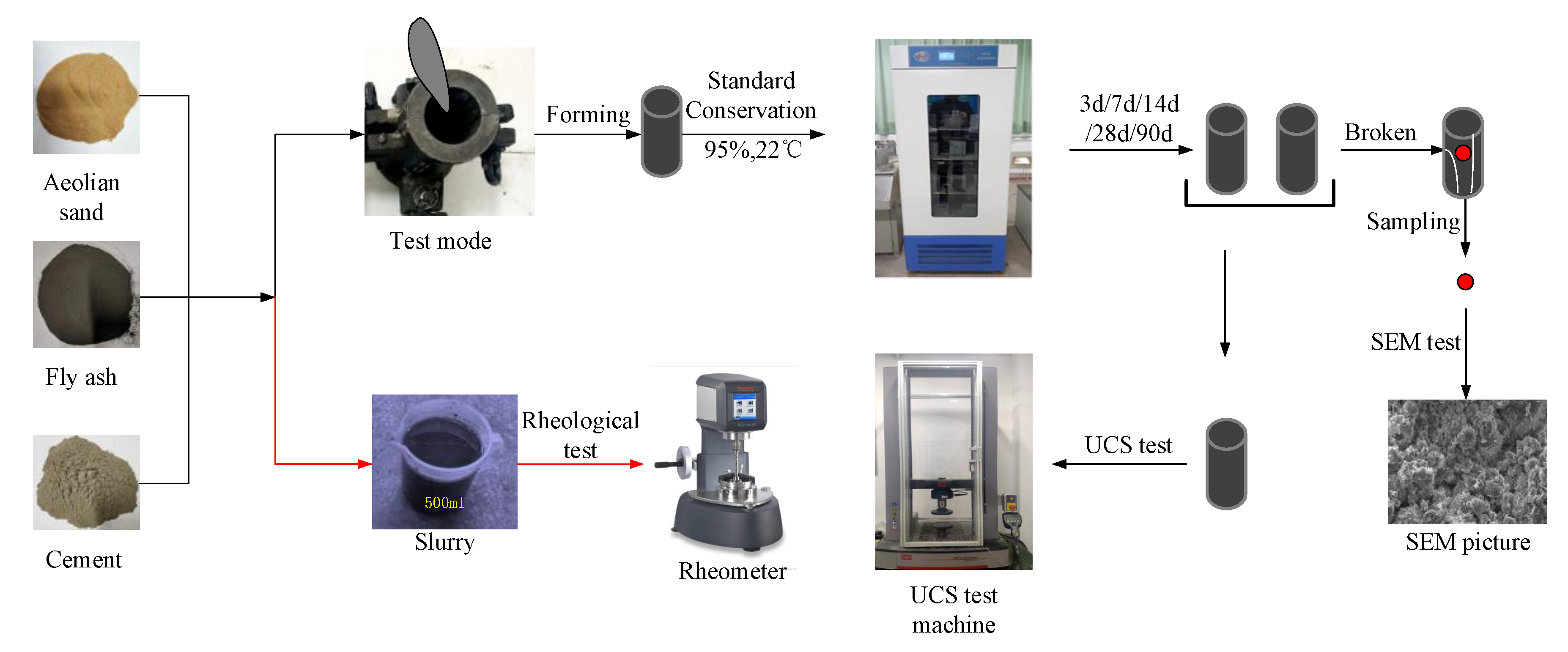
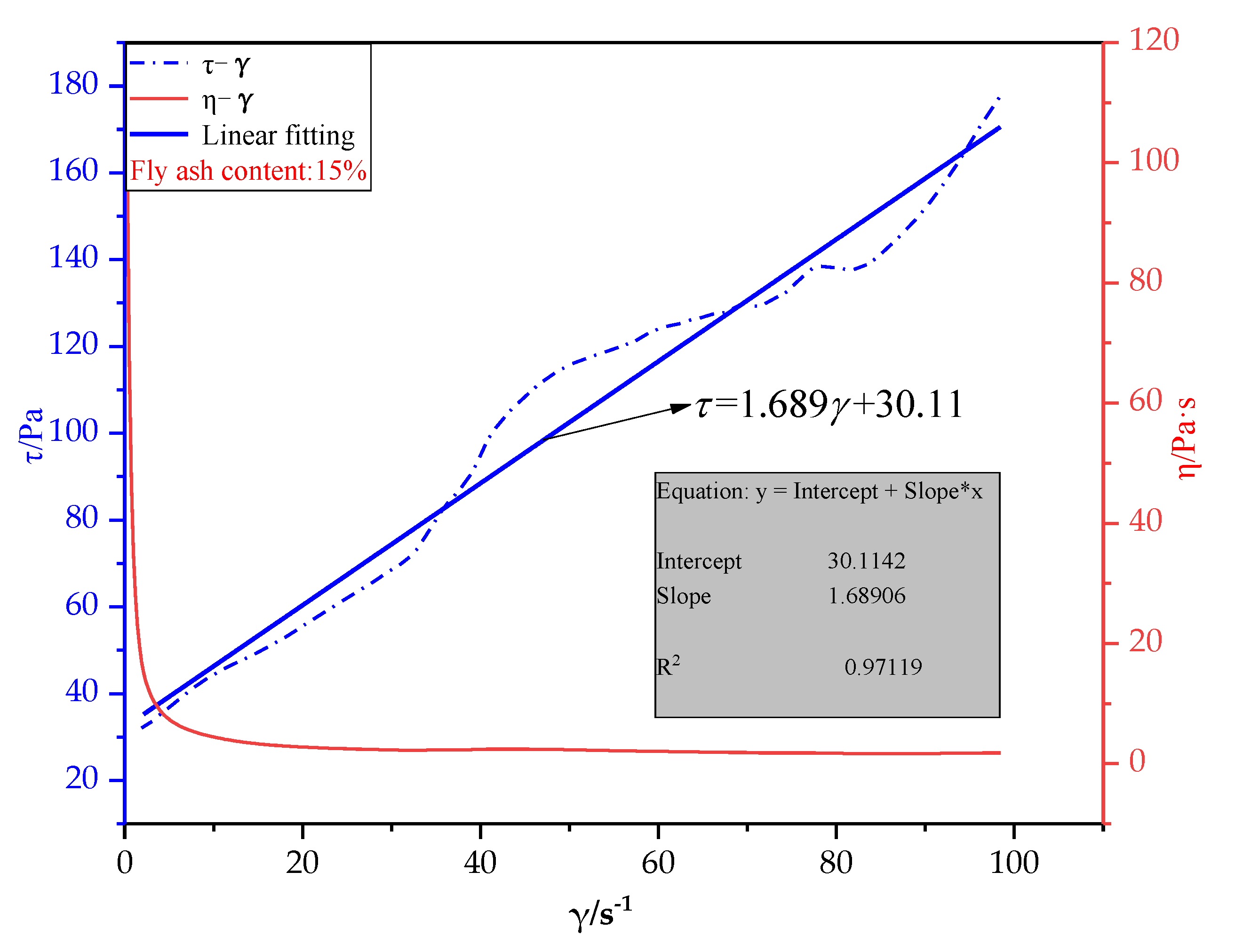
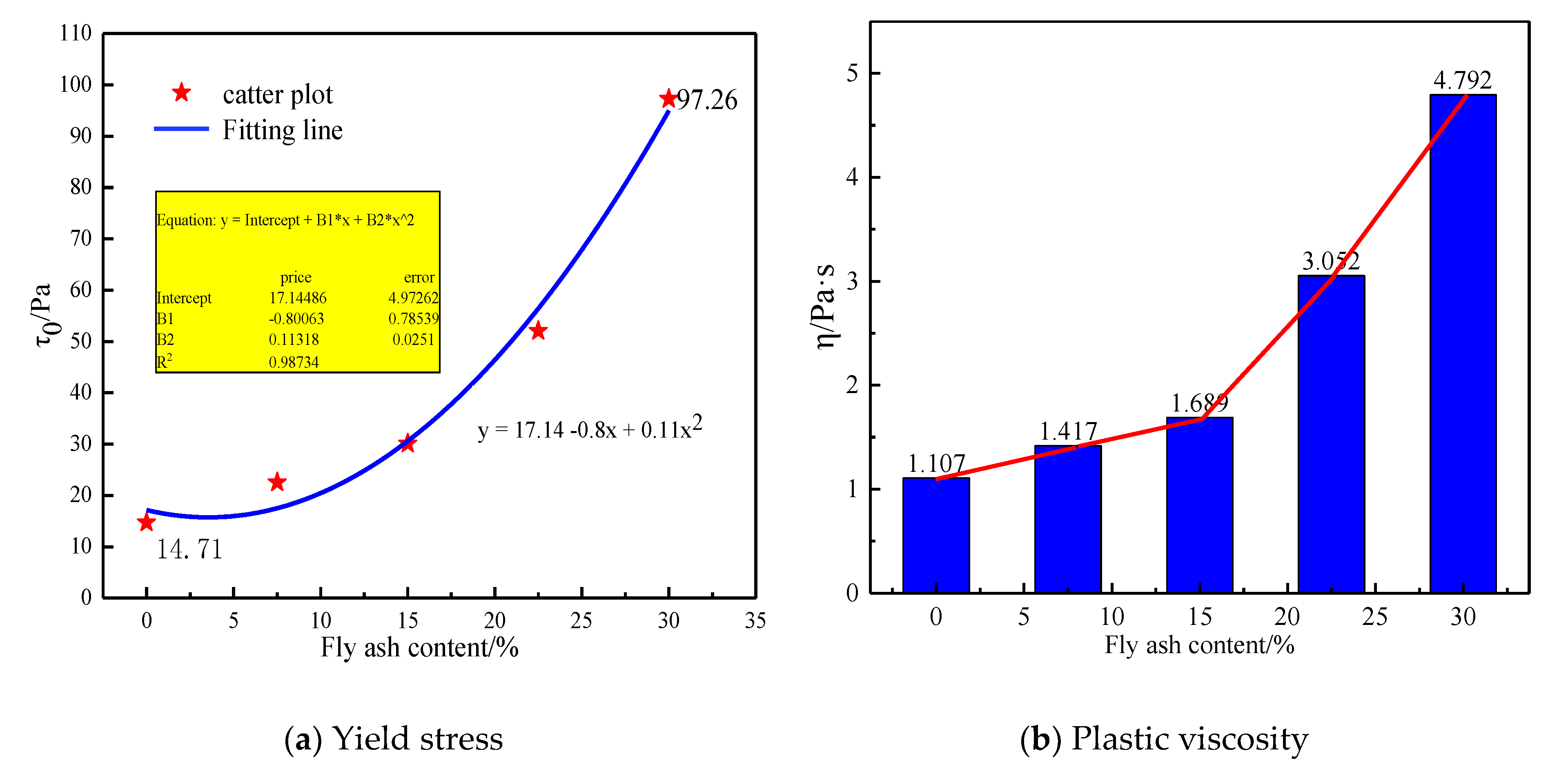
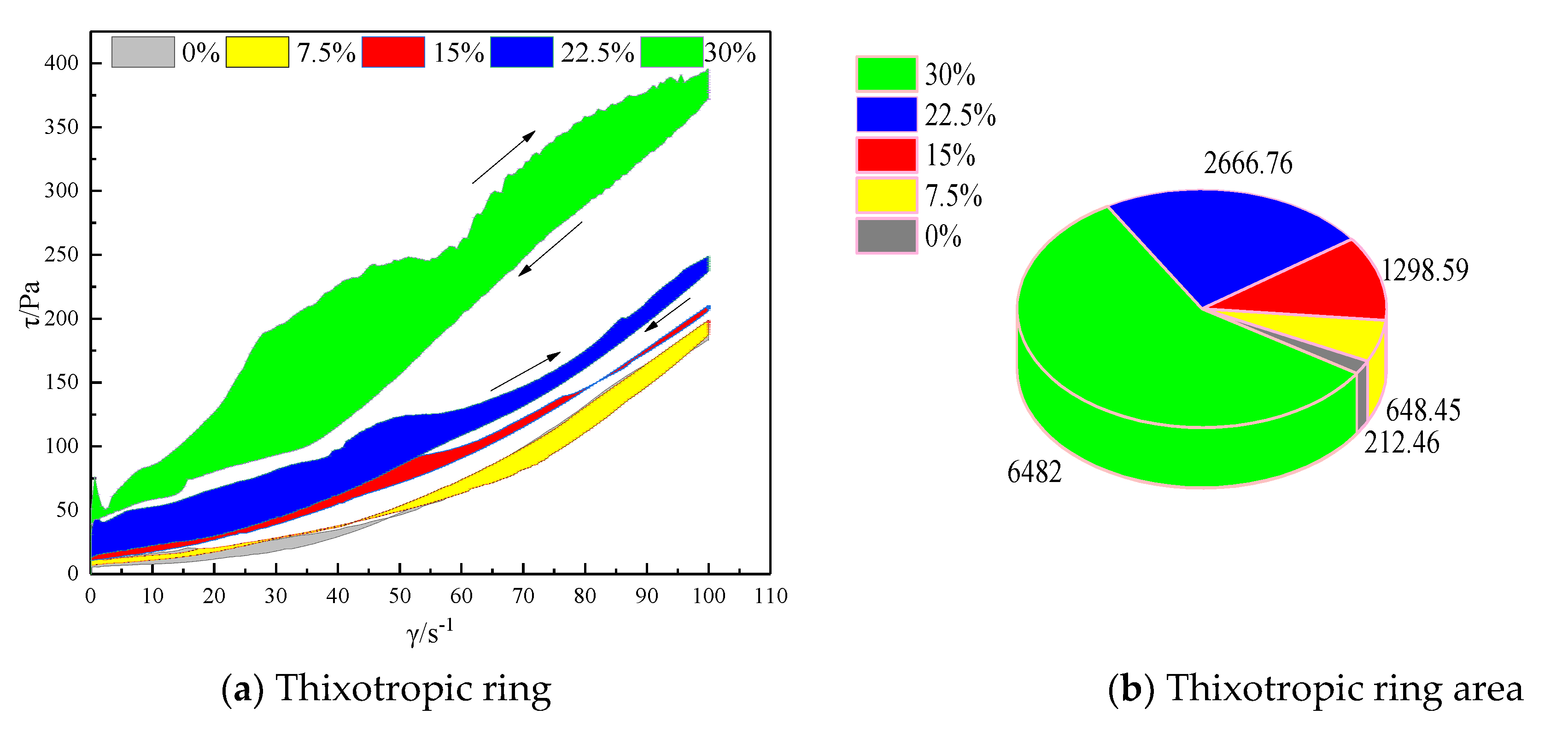
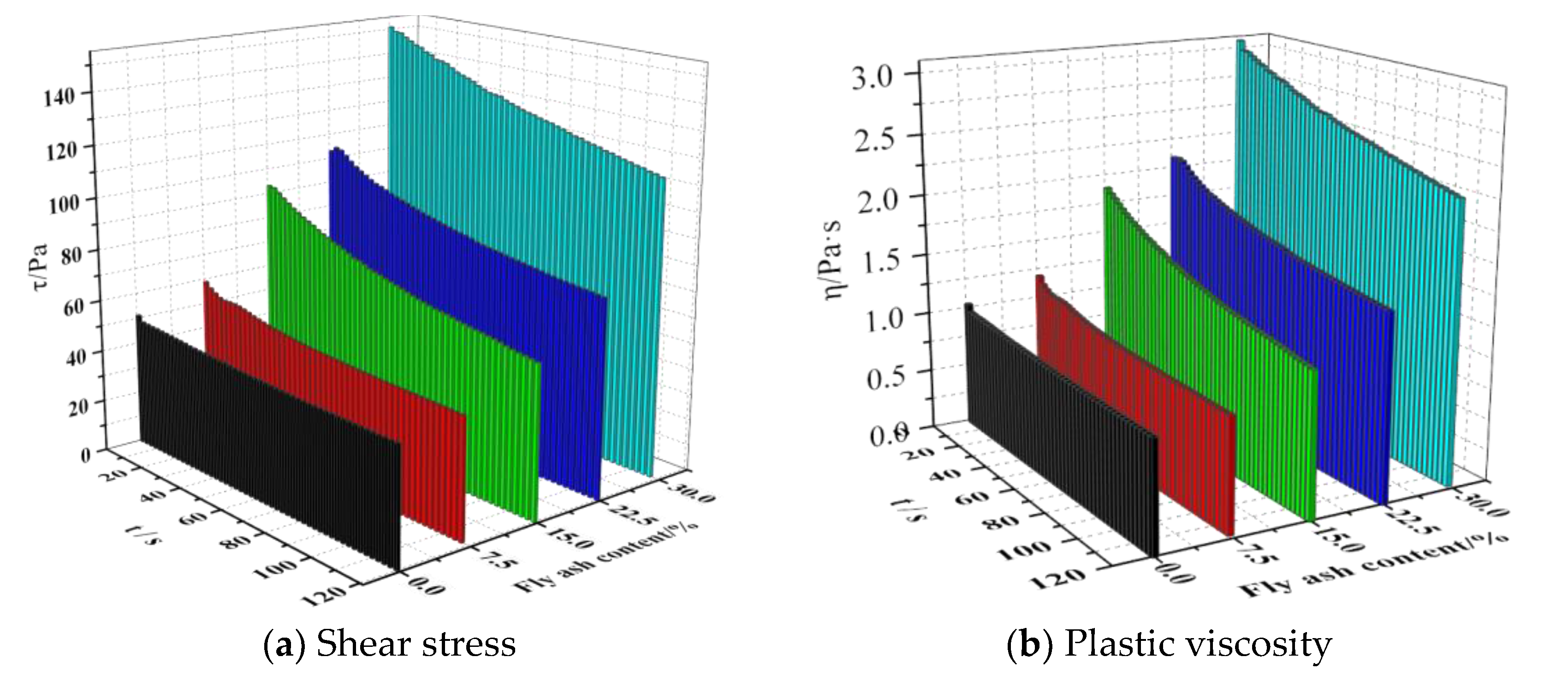
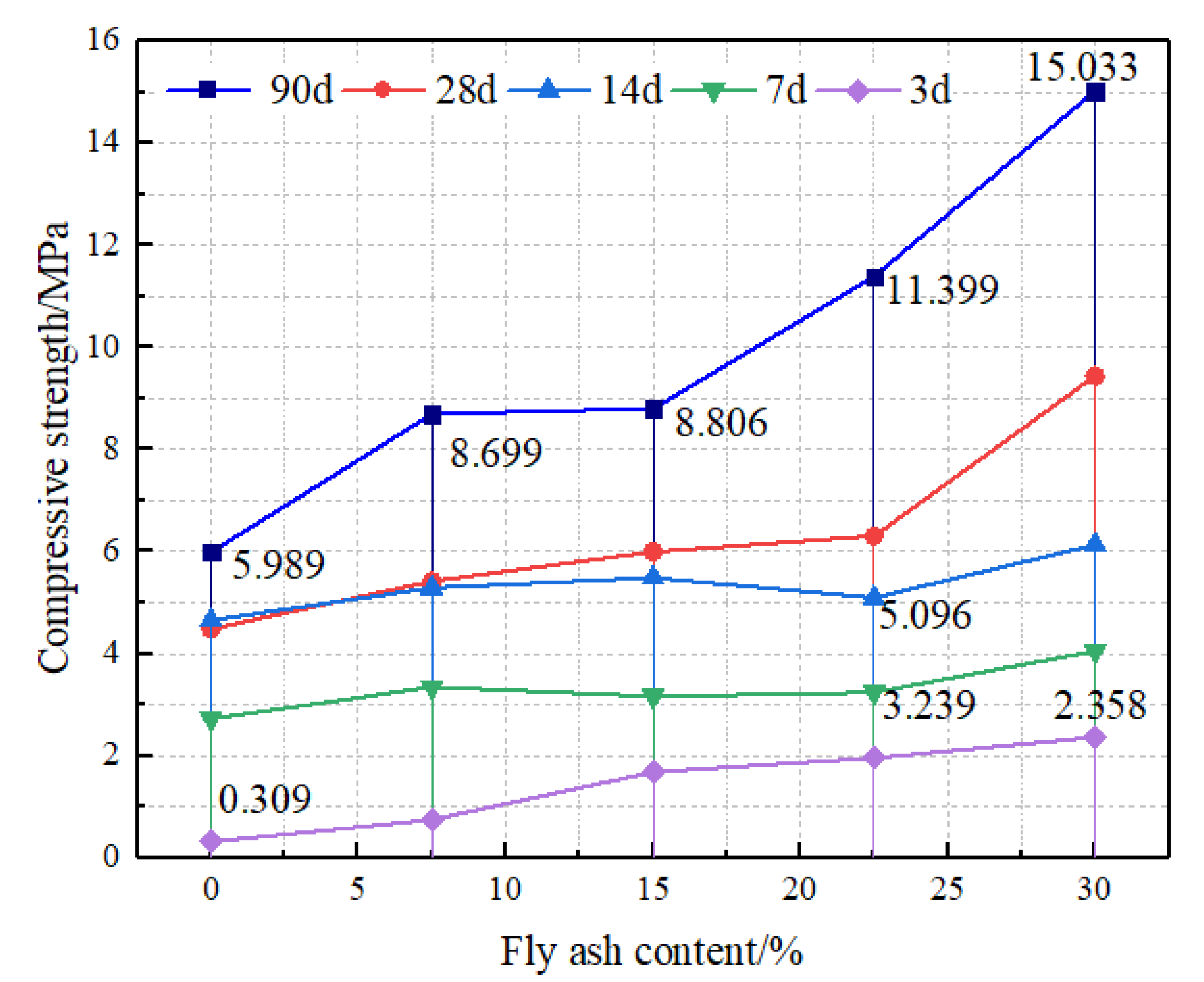

| Composition | AL2O3 | SiO2 | K2O | CaO | Fe2O3 | Others |
|---|---|---|---|---|---|---|
| Content (%) | 10.3 | 67.8 | 7.5 | 5.3 | 5.8 | 3.3 |
| Composition | SiO2 | AI2O3 | Fe2O3 | CaO | K2O | Others |
|---|---|---|---|---|---|---|
| Content (%) | 35.6 | 11.9 | 25.5 | 16.4 | 4.0 | 6.6 |
| Composition | CaO | SiO2 | AL2O3 | MgO | Fe2O3 | Others |
|---|---|---|---|---|---|---|
| Content (%) | 65.08 | 22.36 | 5.53 | 1.27 | 3.46 | 2.30 |
| Group | Mass Ratio of Coal Mine Filling Paste | Fly Ash Content (%) | |||
|---|---|---|---|---|---|
| Aeolian Sand (g) | Fly Ash (g) | Cement (g) | Water (g) | ||
| I | 281 | 0 | 70 | 99 | 0 |
| II | 255 | 26 | 70 | 99 | 7.5 |
| III | 228 | 53 | 70 | 99 | 15 |
| IV | 202 | 79 | 70 | 99 | 22.5 |
| V | 176 | 105 | 70 | 99 | 30 |
| Group | Yield Stress/Pa | Plastic Viscosity/(Pa·s) | Compressive Strength/MPa | ||||
|---|---|---|---|---|---|---|---|
| 3 d | 7 d | 14 d | 28 d | 90 d | |||
| I | 14.71 | 1.107 | 0.309 | 2.725 | 4.653 | 4.482 | 5.989 |
| II | 22.54 | 1.417 | 0.74 | 3.345 | 5.289 | 5.417 | 8.699 |
| III | 30.11 | 1.689 | 1.68 | 3.161 | 5.486 | 5.995 | 8.806 |
| IV | 52.05 | 3.052 | 1.953 | 3.239 | 5.096 | 6.302 | 11.399 |
| V | 97.26 | 4.792 | 2.358 | 4.053 | 6.134 | 9.444 | 15.033 |
© 2020 by the authors. Licensee MDPI, Basel, Switzerland. This article is an open access article distributed under the terms and conditions of the Creative Commons Attribution (CC BY) license (http://creativecommons.org/licenses/by/4.0/).
Share and Cite
Shao, X.; Wang, L.; Li, X.; Fang, Z.; Zhao, B.; Tao, Y.; Liu, L.; Sun, W.; Sun, J. Study on Rheological and Mechanical Properties of Aeolian Sand-Fly Ash-Based Filling Slurry. Energies 2020, 13, 1266. https://doi.org/10.3390/en13051266
Shao X, Wang L, Li X, Fang Z, Zhao B, Tao Y, Liu L, Sun W, Sun J. Study on Rheological and Mechanical Properties of Aeolian Sand-Fly Ash-Based Filling Slurry. Energies. 2020; 13(5):1266. https://doi.org/10.3390/en13051266
Chicago/Turabian StyleShao, Xiaoping, Long Wang, Xin Li, Zhiyu Fang, Bingchao Zhao, Yeqing Tao, Lang Liu, Wuliang Sun, and Jianpeng Sun. 2020. "Study on Rheological and Mechanical Properties of Aeolian Sand-Fly Ash-Based Filling Slurry" Energies 13, no. 5: 1266. https://doi.org/10.3390/en13051266
APA StyleShao, X., Wang, L., Li, X., Fang, Z., Zhao, B., Tao, Y., Liu, L., Sun, W., & Sun, J. (2020). Study on Rheological and Mechanical Properties of Aeolian Sand-Fly Ash-Based Filling Slurry. Energies, 13(5), 1266. https://doi.org/10.3390/en13051266





